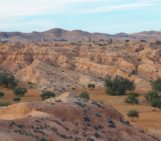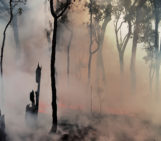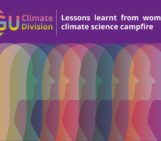
Put a Climate lab in school and make it better
“The car will not go through this road”, the driver replied. Well, the path, which he was mentioning was a mudslide made up of clay soil, completely wet from the rain the previous day. We were traveling to a small village in Sundarban to establish a climate laboratory. The concrete road ends 2 kilometers before the schools, and then it was a mud bath!
Sundarbans, the world’s largest mangrove forest located in southern Bangladesh and India is also becoming more climate-vulnerable due to landfall of multiple cyclones. Nowadays, cyclones are forecasted weeks before their landfall. While state-of-the-art forecasting systems help save lives, people’s livelihoods are still facing major threats. Once fields and freshwater ponds are inundated by seawater during a cyclone, the land remains infertile for years. This pushes people to leave their lands and move elsewhere for their livelihoods. As a result, migration has become a daily incident and climate change is directly affecting the food and water supplies, the fundamental human needs.
In 2019, I co-founded a climate communication platform to disseminate information about the local impact of climate change and adaptation strategies in the local language (Bengali/Bangla). While doing so, I met some incredible human beings and Pulak Roy Chowdhury (headmaster of a rural school in Sundarban named Kanaknagar SD Institution) was definitely one of them. The school itself is among very few cyclone shelter points for the villagers, indicating that the region is climate vulnerable. The school has taken several steps to improve climate resilience. The teacher’s initiative “One Tree for every student” completely transformed the school campus into lush greenness. In addition, this school has a rainwater harvesting facility and generates a significant portion of its own electricity. It grows vegetables and fish for student lunches while providing an after-school self-defense class for the students.
A general approach to taking environmental education as granted has been observed since the introduction of environmental education in the school system. In India, environmental education in schools hasn’t been mainstreamed yet, and this motivates us to set up an observatory where students can monitor changes in micro-climate by measuring basic climate parameters such as rainfall, temperature, relative humidity, etc. Therefore, in 2022, we set up a climate laboratory in the school with weather, water, air, soil, and biodiversity measuring tools. The project aimed to enhance our understanding of local environments, build awareness among students, and create a student-led citizen support system backed by scientific data.
Training components and tools
There are three main components of training for our students:
a. The Environmental Laboratory – consists of a weather station, water quality analyzers, soil quality testing kits, and air quality monitors. The data are then continuously uploaded to our open-sourced servers. Students create a weather dashboard, water museum, as well as soil and air quality maps of their surrounding areas.
b. Education- involves how to identify risks and adaptation for climate change in the locality. It consists of a demonstration of tools such as a small greenhouse, urban heat islands, air pollution catchers, simple waste management through composting, coliform bacteria detection in water, land use map creation, solar and wind energy calculator, and DIY water quality filter. The tool for doing a water and energy budget for the schools is also demonstrated and the students are creating an inventory of waste, water, and energy.
c. Demonstration of low-cost solutions for climate resilience – In this category, we demonstrate solutions to the students with a DIY approach. They learn how to build air pollution filters, paper recycling, water conservation facet, energy savings lights, solar-powered electrical consumptions, vertical gardening, etc.
Setting up the laboratories
Every year each school selects 50-60 students from different classes and forms five groups; each group leads one major environmental component; such as air, water, soil, weather, and biodiversity (Fig 1). Each group is assigned a teacher who provides them with the necessary training. Objective-oriented goals have been set up for each group. For example, “Team Air” investigate PM2.5 in different microenvironments; “Team Weather” looks into daily weather updates, acid rain, real-time weather alerts; “Team Water” collects and analyses water from local waterbodies and creates a water museum; “Team Soil” looked into organic carbon and NPK in different stages of farming practices; “Team Biodiversity” engage in collecting, preserving and documenting local indigenous landraces of crops, fish, butterflies, and birds. The instruments and kits that have been set up in the laboratory are either IoT-based (Internet of Things) equipment or established chemical methods for detecting pollutants. Therefore, they are easy to use and easily replaceable. Posters and other DIY instructions are displayed on the school premises and team members from each of the groups present their findings during the morning assembly at regular intervals. Parallelly, disaster response training during cyclones, floods, and lightning is provided through practical demonstrations as well as posters installed in the school.
Scaling up
Environmental laboratories have been established in three schools in Sundarbans, Purulia, and North 24Parganas district of West Bengal, India (Fig 2). All three of these schools are situated in rural areas, where the majority of the student’s parents work as farmers. The schools are:
a) Kanaknagar SD Institution, Hingalganj
b) Mena Sorojini Pahar High School, Habra
c) Goalpara Junior High School, Raghunathpur.
These schools are located in different geographical zones and suffer different impacts due to climate change. A brief description of climatic impact in Sundarban has been described previously and in Sundarban, the focus of environmental parameters to record are rainfall, windspeed, soil and water salinity, and pH, PM2.5. The school in Purulia is severely impacted by heatwaves and drought, here the focus is to measure relative humidity, temperature, soil water retention capacity, soil moisture, soil carbon, total dissolved solids, and pH of water (Fig 3). The school in North 24Parganas is primarily focused on measuring the physical and chemical properties of water, rainfall, soil NPK, and PM2.5. Here, the local area is impacted by flash floods, water contamination, and soil degradation.
Results
Activities such as daily weather reports, acid rain event measurements, heat wave observations, and regular monitoring of soil and water are ongoing. The water museum with 75+ water samples and 12 parameters for each of the samples, is displayed in the schools (Fig 4). The school weather station in Sundarban helped local villagers during a recent cyclone event (Cyclone Fani). The real-time weather station data was used as a decision-making tool for evacuation in this case. Teachers and students have distributed responsibility. I talk with the students when they have some questions regarding interpreting data or they want to share some observations.
From educator to change maker
I am no stranger to educating citizens about climate change. In 2019, I co-founded the Bengali communication platform on climate change, called “Sobuj Prithibi” (www.sobujprithibi.in), and over the years it has reached millions of people. Our dedicated team has already facilitated over 100 workshops and more than 20 sessions that brought scientists and farmers together to discuss climate change. But in this project, the role of our team is a little bit different. Here, we established a laboratory, provided the necessary training for teachers and students; and then interacted with the students while interpreting the data. We avoid micro-managing the climate laboratory program, instead enabling the school instructors to take the lead. In this setting, we consider ourselves as catalysts, facilitating but not dominating the process. We are confident that these youngsters will become the next generation of climate activists, advocating for both local adaptation and global mitigation measures.
Acknowledgment
The project cannot be completed without the support of Sandip and Srijan from The Climate Thinker. The teachers are incredible in these schools. Also, the EGU communication grant helped me in buying instruments, logistics, and providing communication material in school.
This blog was edited by the CL editorial board.







